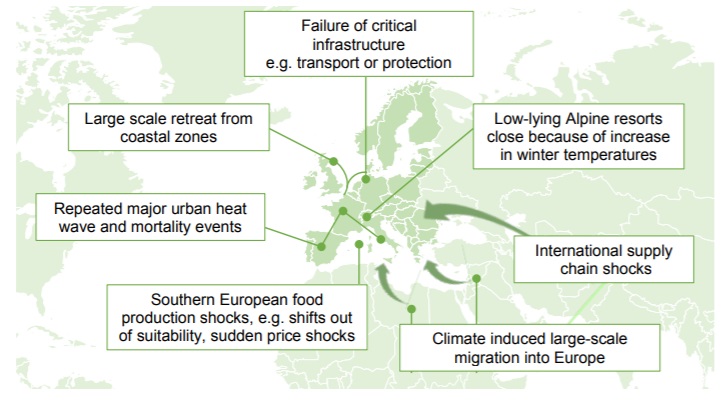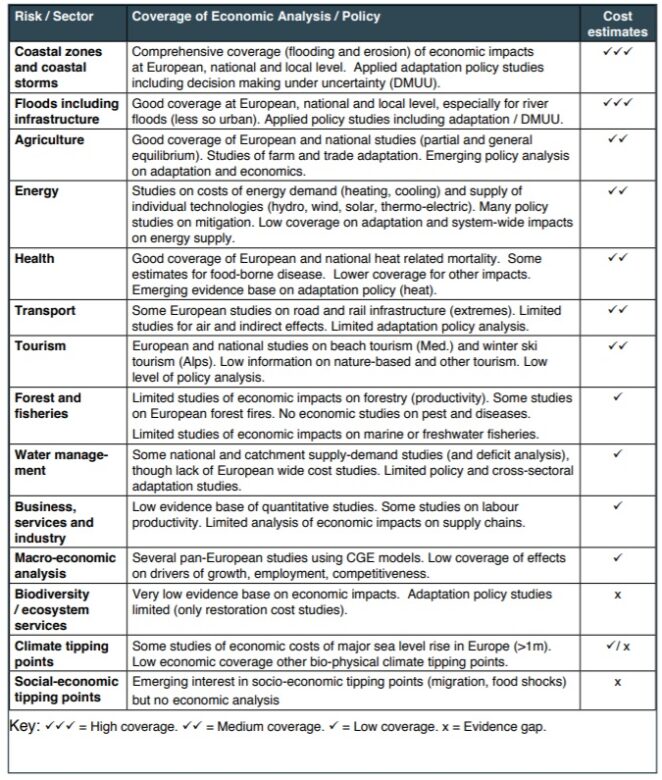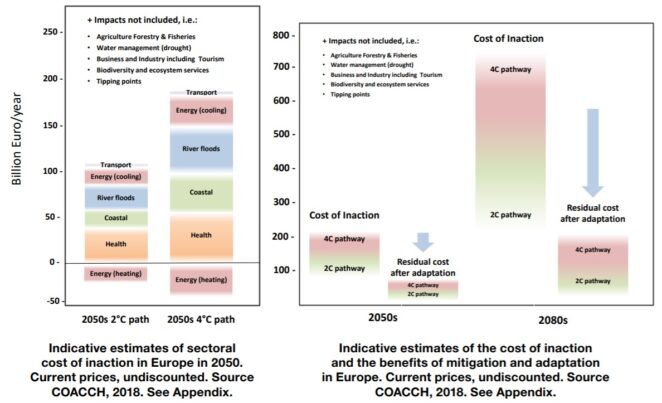Article /
The Economic Cost of Climate Change in Europe: Synthesis Report on State of Knowledge and Key Research Gaps

Introduction
The objective of the COACCH project (CO-designing the Assessment of Climate CHange costs) is to produce an improved downscaled assessment of the economic costs of climate change in Europe that is of direct use to end users from the research, business, investment and policy making community.
To help inform the framing of the project and the first stakeholder workshop, the project has undertaken a review of the current knowledge* on the economic costs of climate change in Europe.
*Download the full review from the right-hand column. Below is a summary of the key insights from the report. See the full text for much more detail and sector-by-sector specific information.
Methods and Tools
Climate projections for Europe
The most recent downscale climate projections for Europe are available from EUROCORDEX.
- These reconfirm that Europe will warm more than the global average, i.e. Europe will experience more than 2°C of warming (relative to preindustrial levels) even if the Paris goal is achieved in terms of emissions.
- There are also projected increases in extreme events in Europe even for 2°C of global change, which will cause more frequent and severe impacts.
- However, the patterns differ across Europe.
There are also robust model findings of increases in heavy precipitation in Europe, in both summer and winter, with (ensemble mean) intensity increasing by +5% to 15% (and in some areas, even more), even under the 2°C scenario.
- The projected increase in heavy preciptation is expected also over regions experiencing a reduction of the average precipitation (such as southern Europe).
- These increases drive the potential increases in flood risk.
It is highlighted that these results involve ‘uncertainty’.
- One unknown factor affecting future climate is the greenhouse gas (GHG) emission path (the future representative concentration pathway, RCP), though this can be considered with multiple scenarios (as above).
- Another factor is that climate models do not all give the same results, though this can be considered by using different models.
- It is essential to recognise this uncertainty, not to ignore it or use it as a reason for inaction.
Economic cost estimates
The sector studies in this review report monetised impacts in terms of social welfare.
- This captures the costs and benefits to society, i.e. market and non-market impacts.
- These estimates are presented in terms of current prices (Euros) for future time periods, without adjustment or discounting.
- This facilitates direct comparison, over time and between sectors.
- However, as the review collates information from different studies, some care must be taken in comparing values.
- The results are from studies that have used different methods, scenarios and time periods.
- Furthermore, sometimes results are reported as the marginal impacts of climate change (alone), while sometimes they are the combined impacts of future climate and socioeconomic change together.
Outcomes and Impacts
The following table summarises the key messages of the report for each sector analysed:

Lessons Learnt
The review shows that the evidence base on the costs of inaction, and the economic benefits of mitigation and adaptation are increasing, but major gaps in our knowledge remain.
The synthesis also provides a number of early policy-relevant findings:
- First, the review indicates that the costs of inaction will be potentially large in Europe.
- The figure below presents the evidence collated in this review. Details of the exact studies used are included in the appendix.
- It is clear that the economic costs in Europe, even by mid-century, significantly differ depending on whether the world is on a 2° or 4°C pathway.

- Second, the review provides evidence of the significant economic benefits to be gained from mitigation, but also from adaptation, to reduce the costs of inaction.
- These economic benefits rise strongly towards the end of the century.
- Finally, these aggregate costs mask considerable differences in the distribution of economic costs across Europe and in individual Member States.
- It is important to analyse economic costs at this disaggregated level, as planned in the COACCH project, because many impacts converge on particular geographical areas.
Moving forward, the COACCH project will build on this evidence base, co-designing its research activities in direct collaboration with stakeholders to define and address key gaps and information needs and to advance the policy debate.
Suggested citation
COACCH (2018). The Economic Cost of Climate Change in Europe: Synthesis Report on State of Knowledge and Key Research Gaps. Policy brief by the COACCH project. Editors:Paul Watkiss, Jenny Troeltzsch, Katriona McGlade. Published May , 2018.
Further reading
- CO-designing the Assessment of Climate CHange costs (COACCH)
- Theme: Economics of climate adaptation
- Assessing credit risk and opportunity in a changing climate: Outputs of a working group of 16 banks piloting the TCFD Recommendations
- Analyzing the Economic Costs and Benefits of Climate Change Adaptation Options
- Assessing adaptation knowledge in Europe: vulnerability to climate change
Related reading:
- 10 Things to Know About the IPCC Scenario Framework
- Climate Change Scenario Primer
- Are European decision-makers preparing for high-end climate change?
- Weather worries: the future of Europe depends on how it manages the risks of climate extremes
- Assessing adaptation knowledge in Europe: vulnerability to climate change
